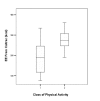Validating MOSPA questionnaire for measuring physical activity in Pakistani women
- PMID: 16901346
- PMCID: PMC1560391
- DOI: 10.1186/1475-2891-5-18
Validating MOSPA questionnaire for measuring physical activity in Pakistani women
Abstract
Background: Precise measurements of activity at a population level are important for monitoring trends and evaluating health promotion strategies. Few studies have assessed the measurement of physical activity in developing countries. The aim of this study was to validate the MOSPA (Monica Optional Study of Physical Activity) questionnaire which was developed for the WHO-Monitoring trends and determinants of cardiovasculr disease (MONICA) study sites.
Methods: The MOSPA questionnaire assesses energy expendtiture (EE) related to physical activity (employment, household work, transportation, and leisure time) over a one year period. This questionnaire has been described in the manuscript as the long term (LT) questionnaire. An adapted short term (ST) 5 day questionnaire was developed to assess convergent validity. Questionnaire data were compared with physical activity EE estimates from a Caltrac accelerometer and with body composition measures (height, weight and bioelectrical impedance) in 50 women from the Aga Khan University (AKU) hospital antenatal clinics, Pakistan. Other forms of EE i.e. resting EE and thermic effect of food were not assessd in this study.
Results: Subjects were aged 26 +/- 3.8 years and were 16.1 +/- 6.7 weeks pregnant. Their average weight was 58.8 +/- 10.7 Kg. The average EE/day assessed by the Caltrac accelerometer, was 224 kcal and by MOSPA LT questionnaire it was 404 kcal. The questionnaires and Caltrac data were reasonably well correlated: r = 0.51 and r = 0.60 (P < 0.01) for LT and ST questionnaires respectively. Energy expenditure from questionnaire data was not correlated with body composition measures.
Conclusion: The MOSPA questionnaire is useful in assessing physical activity levels in a sedentary population over a one year period.
Figures
Similar articles
-
Reliability and validity of self-reported physical activity in the Nord-Trøndelag Health Study: HUNT 1.Scand J Public Health. 2008 Jan;36(1):52-61. doi: 10.1177/1403494807085373. Scand J Public Health. 2008. PMID: 18426785
-
Reliability and validity of the international physical activity questionnaire in the Nord-Trøndelag health study (HUNT) population of men.BMC Med Res Methodol. 2008 Oct 9;8:63. doi: 10.1186/1471-2288-8-63. BMC Med Res Methodol. 2008. PMID: 18844976 Free PMC article.
-
Physical activity questionnaire for adolescents validated against doubly labelled water.Eur J Clin Nutr. 2005 Mar;59(3):376-83. doi: 10.1038/sj.ejcn.1602084. Eur J Clin Nutr. 2005. PMID: 15536471
-
Measuring physical activity and sedentary behaviour at work: a review.Work. 2011;40(4):345-57. doi: 10.3233/WOR-2011-1246. Work. 2011. PMID: 22130052 Review.
-
[Measurement and assessment of habitual physical activity in epidemiological studies].Harefuah. 2005 Mar;144(3):200-5, 230, 229. Harefuah. 2005. PMID: 15844461 Review. Hebrew.
Cited by
-
New Insights on Bone Tissue and Structural Muscle-Bone Unit in Constitutional Thinness.Front Physiol. 2022 Jul 8;13:921351. doi: 10.3389/fphys.2022.921351. eCollection 2022. Front Physiol. 2022. PMID: 35874537 Free PMC article.
-
Is constitutional thinness really different from anorexia nervosa? A systematic review and meta-analysis.Rev Endocr Metab Disord. 2021 Dec;22(4):913-971. doi: 10.1007/s11154-021-09650-4. Epub 2021 Apr 30. Rev Endocr Metab Disord. 2021. PMID: 33929658
-
Neuropeptide Y and α-MSH circadian levels in two populations with low body weight: anorexia nervosa and constitutional thinness.PLoS One. 2015 Mar 23;10(3):e0122040. doi: 10.1371/journal.pone.0122040. eCollection 2015. PLoS One. 2015. PMID: 25798605 Free PMC article.
-
Validity of two physical activity questionnaires (IPAQ and PAQA) for Vietnamese adolescents in rural and urban areas.Int J Behav Nutr Phys Act. 2008 Jul 10;5:37. doi: 10.1186/1479-5868-5-37. Int J Behav Nutr Phys Act. 2008. PMID: 18616798 Free PMC article.
-
Resistance to lean mass gain in constitutional thinness in free-living conditions is not overpassed by overfeeding.J Cachexia Sarcopenia Muscle. 2020 Oct;11(5):1187-1199. doi: 10.1002/jcsm.12572. Epub 2020 Apr 10. J Cachexia Sarcopenia Muscle. 2020. PMID: 32274897 Free PMC article.
References
-
- Fact Sheet on physical activity. WHO Report. 2003. http://www.who.int/hpr/NPH/docs/gs_physical_activity.pdf
-
- Singh RB, Ghosh S, Niaz AM, Gupta S, Bishnoi I, Sharma JP, Agarwal P, Rastogi SS, Beegum R, Chibo H, Shoumin Z. Epidemiologic study of diet and coronary risk factors in relation to central obesity and insulin levels in rural and urban populations of north India. Int J Cardiol. 1995;47:245–255. doi: 10.1016/0167-5273(94)02186-M. - DOI - PubMed
-
- The nutrition transition and obesity. FAO. 2003. http://www.fao.org/focus/e/obesity/obes2.htm
-
- CDC Physical activity trends – United States, 1990–1998. MMWR Morb Mortal Wkly Rep. 2001;50:166–169. - PubMed
-
- Hayes L, White M, Unwin N, Bhopal R, Fischbacher C, Harland J, Alberti KGMM. Patterns of physical activity and relationship with risk markers for cardiovascular disease and diabetes in Indian, Pakistani, Bangladeshi and European adults in a UK population. J Public Health Med. 2002;24:170–178. doi: 10.1093/pubmed/24.3.170. - DOI - PubMed
MeSH terms
LinkOut - more resources
Full Text Sources
Medical
Miscellaneous


